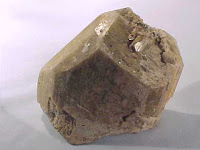What is Feldspathic Sandstone?
See if you can find your answer...
If you want to get to the very core of the idea and can make sense of these sort of 3-D projected graphs....please see below
For those of us who cannot make heads or tails of that sort of thing...see further below.
As you will recall feldspars are the most common minerals in igneous and metamorphic rocks..So it is natural for debris close to a tectonic uplift and erosion area to be rich in these minerals.
However feldspars are less stable than quartz at conditions near the Earth's surface which means they will erode even further than most other minerals found in sand.
If you thought about that even further you would understand why there are not many feldspathic sandstones...most large masses of sand make several trips tumbling down mountains and washing up on the coast.
Feldspar Minerals
Plagioclase - usually showing albite twinning. Such plagioclase can be derived from both igneous and metamorphic sources. If the plagioclase also shows zoning, then it is likely from a volcanic source.
Alkali Feldspar - Orthoclase and microcline are derived from both igneous and metamorphic sources. Sanidine is derived from volcanic sources. Microperthite, the intergrowth of K-rich and Na-rich alkali feldspars, is likely derived from a plutonic igneous source.
And other trace minerals...depending on the specific parent rock.
In thin section you may have difficulty identifying these minerals because of their nature to decay and change into other minerals called alteration minerals.
So when classifying a sandstone in particular the more feldspar present the less mature the stone.
Maturity in this case refers to the amount of time the particular body of sand traveled before it was brought to a halt and deposited underwent compaction until it was a stone.



